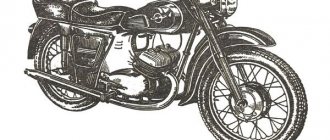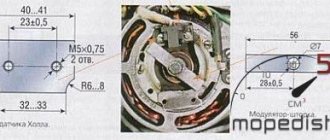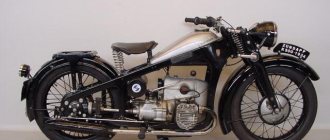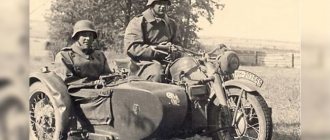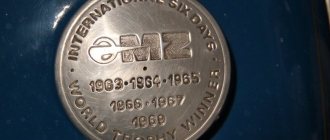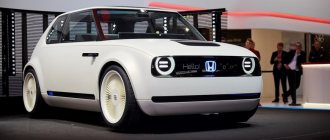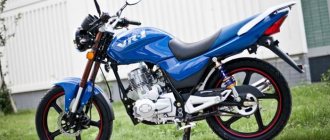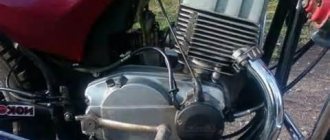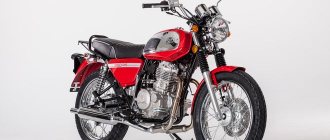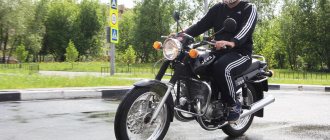This term has other meanings, see Pannonia.
| Pannonia | |
| |
| general information | |
| Other names | Pannonia |
| Years of manufacture | 1956—1975 |
| Components | |
| Engine | |
Pannonia
(Russian:
Pannonia
) is a brand of motorcycles produced by the Hungarian plant Csepel from 1956 to 1975.
History of the brand
The Csepel machine-building plant, located in the suburb of Budapest of the same name, began producing motorcycles in 1947 with the development of a copy of the German model DKW RT 125
. Initially, the motorcycles were branded “Chepel”. In 1954, the plant mastered a new model TL 250 with an engine capacity of 250 cm3. Since 1956, it began to be sold under the Pannonia brand[1][2].
After the modernization, the production of motorcycles of the TLT and then TLF series began. The TLF series had modifications: TLB with two separate saddles and TLD with ignition from a 60-watt generator. The TLT series began the export of Pannonia motorcycles to the USSR, which became the main consumer of these motorcycles outside of Hungary. Exports to the USSR reached 25,000 motorcycles per year. In addition to the USSR, Pannonia motorcycles were supplied to many other countries, including the USA. In total, up to 70% of the products were exported[1].
By the beginning of the 70s, the T5 and P10 models produced by the company, which represented a further modernization of the TL series, were outdated. In this regard, in 1968, the plant, under license, mastered the production of the P20 series, which was a copy of the Yamaha YDS-2
. The motorcycle was very technically advanced for its time. However, the USSR refused to purchase such complex and expensive motorcycles. The company had problems selling its products. Because of this, in 1975, Csepel decided to stop producing motorcycles.[1]
In total, during the period from 1954 to 1975, the Chepel plant produced more than 600,000 motorcycles[1]. Of these, in the period from 1956 to 1975, 286,959 units were exported to the USSR[3].
Electrical equipment
“Pannonia” is equipped with an inertial-type flywheel ignition, voltage 6 volts, power 45 watts. The dyna is mounted on the end of the main drive shaft and interacts with the voltage regulator and generator. The spark plug is standard, M14 from Bosch. The power supply circuit for on-board consumers is common, adopted for most middle-class motorcycles. Six-volt lighting bulbs do not quite meet the requirements for night use; they are low-power. Otherwise, the electrical equipment of the motorcycle is quite reliable and does not require adjustment.
Gallery
- Csepel 250 oldalkocsival.JPG
Csepel 250/51 EF
- Pannonia.jpg
Pannonia TLT 250
- Pannonia Csepel 250 T1 Side 1959a.JPG
Pannonia 250 T1
- Pannonia TLB De Luxe 250.jpg
Pannonia TLB De Luxe 250
- Pannonia Csepel 250 T5 1960.JPG
Pannonia 250 T5
- Pannonia P 12.JPG
Pannonia P12
Repair
Like any motorcycle from the middle of the last century, the Pannonia needs restoration. The motorcycle mainly needs cosmetic repairs, the paintwork must be flawless, the engine must be cleaned, the tail surfaces must be polished. At the same time, the car requires competent technical rehabilitation. All components and assemblies undergo diagnostics, and after all defects are identified, major repairs can begin. Spare parts for the Pannonia motorcycle have been in short supply for a long time, but it is precisely because of this that the necessary parts can still be found. If you regularly visit the weekend market selling repair supplies, you can find any spare parts to replace the ones that have failed.
Notes
- ↑ 1 2 3 4
Encyclopedia of motorcycles (Companies, Models, Designs) /
A. E. Vorontsov, E. V. Pevzner, D. V. Dolnikov, A. G. Popov, R. M. Sazonov
. — M: Za Rulem Publishing House, 2003. - Shugurov L. Motorcycle Pannonia // Moto, 1994, No. 2
- [rcforum.ru/showpost.php?p=2140461&postcount=14 RC-Forum - forum for collectors of scale models - Show message separately - Pannonia, Csepel, Hungary - Poland]
Motorcycle "Pannonia": technical characteristics
The motorcycle is characterized by the following indicators:
- engine - single-cylinder, two-stroke;
- cylinder volume - 246 cm3;
- piston stroke - 68 mm;
- compression ratio - 39.8;
- cylinder diameter - 68 mm;
- maximum power - 14 hp;
- maximum speed - 110 km/h;
- wheelbase - 1380 mm;
- motorcycle length - 2100 mm;
- height - 980 mm;
- distance from the steering wheel to the front saddle - 650 mm;
- width - 680 mm;
- ground clearance - 130 mm;
- weight - 146 mm;
- gas tank capacity - 18 liters;
- reserve capacity for refueling, with switch - 4 liters.
The Pannonia motorcycle, the characteristics of which were already at a fairly high level, was nevertheless constantly improved during the production process. There were no fundamental changes, but during the assembly line small changes were regularly made that helped improve the image of the car. Particular attention was paid to the level of comfort of the “Pannonia”, the saddles were separated, and the shock absorption was improved.
Excerpt characterizing Pannonia (motorcycle)
- Oh, how lovely! Well, now sleep, and that's the end. “You sleep, but I can’t,” answered the first voice approaching the window. She apparently leaned out of the window completely, because the rustling of her dress and even her breathing could be heard. Everything became quiet and petrified, like the moon and its light and shadows. Prince Andrei was also afraid to move, so as not to betray his involuntary presence. - Sonya! Sonya! – the first voice was heard again. - Well, how can you sleep! Look what a beauty it is! Oh, how lovely! “Wake up, Sonya,” she said almost with tears in her voice. - After all, such a lovely night has never, never happened. Sonya reluctantly answered something. - No, look what a moon it is!... Oh, how lovely! Come here. Darling, my dear, come here. Well, do you see? So I would squat down, like this, I would grab myself under the knees - tighter, as tight as possible - you have to strain. Like this! - Come on, you'll fall. There was a struggle and Sonya’s dissatisfied voice: “It’s two o’clock.” - Oh, you're just ruining everything for me. Well, go, go. Again everything fell silent, but Prince Andrei knew that she was still sitting here, he sometimes heard quiet movements, sometimes sighs. - Oh my god! My God! what is this! – she suddenly screamed. - Sleep like that! – and slammed the window. “And they don’t care about my existence!” thought Prince Andrei as he listened to her conversation, for some reason expecting and fearing that she would say something about him. - “And there she is again! And how on purpose!” he thought. In his soul suddenly arose such an unexpected confusion of young thoughts and hopes, contradicting his whole life, that he, feeling unable to understand his condition, immediately fell asleep. The next day, having said goodbye to only one count, without waiting for the ladies to leave, Prince Andrei went home. It was already the beginning of June when Prince Andrei, returning home, again drove into that birch grove in which this old, gnarled oak had struck him so strangely and memorably. The bells rang even more muffled in the forest than a month and a half ago; everything was full, shady and dense; and the young spruces, scattered throughout the forest, did not disturb the overall beauty and, imitating the general character, were tenderly green with fluffy young shoots. It was hot all day, a thunderstorm was gathering somewhere, but only a small cloud splashed on the dust of the road and on the succulent leaves. The left side of the forest was dark, in shadow; the right one, wet and glossy, glistened in the sun, slightly swaying in the wind. Everything was in bloom; the nightingales chattered and rolled, now close, now far away. “Yes, here, in this forest, there was this oak tree with which we agreed,” thought Prince Andrei. “Where is he,” Prince Andrei thought again, looking at the left side of the road and without knowing it, without recognizing him, he admired the oak tree that he was looking for. The old oak tree, completely transformed, spread out like a tent of lush, dark greenery, swayed slightly, swaying slightly in the rays of the evening sun. No gnarled fingers, no sores, no old mistrust and grief - nothing was visible. Juicy, young leaves broke through the tough, hundred-year-old bark without knots, so it was impossible to believe that this old man had produced them. “Yes, this is that same oak tree,” thought Prince Andrei, and suddenly an unreasonable, spring feeling of joy and renewal came over him. All the best moments of his life suddenly came back to him at the same time. And Austerlitz with the high sky, and the dead, reproachful face of his wife, and Pierre on the ferry, and the girl excited by the beauty of the night, and this night, and the moon - and all this suddenly came to his mind. “No, life is not over at the age of 31, Prince Andrei suddenly finally, permanently decided. Not only do I know everything that is in me, it is necessary for everyone to know it: both Pierre and this girl who wanted to fly into the sky, it is necessary for everyone to know me, so that my life does not go on for me alone So that they don’t live so independently of my life, so that it affects everyone and so that they all live with me!” Returning from his trip, Prince Andrei decided to go to St. Petersburg in the fall and came up with various reasons for this decision. A whole series of reasonable, logical arguments why he needed to go to St. Petersburg and even serve were ready at his service every minute. Even now he did not understand how he could ever doubt the need to take an active part in life, just as a month ago he did not understand how the thought of leaving the village could have occurred to him. It seemed clear to him that all his experiences in life would have been in vain and would have been meaningless if he had not applied them to action and taken an active part in life again. He did not even understand how, on the basis of the same poor reasonable arguments, it had previously been obvious that he would have humiliated himself if now, after his life lessons, he again believed in the possibility of being useful and in the possibility of happiness and love. Now my mind suggested something completely different. After this trip, Prince Andrei began to get bored in the village, his previous activities did not interest him, and often, sitting alone in his office, he got up, went to the mirror and looked at his face for a long time. Then he turned away and looked at the portrait of the deceased Lisa, who, with her curls whipped up a la grecque [in Greek], tenderly and cheerfully looked at him from the golden frame. She no longer spoke the same terrible words to her husband; she simply and cheerfully looked at him with curiosity. And Prince Andrei, clasping his hands back, walked around the room for a long time, now frowning, now smiling, reconsidering those unreasonable, inexpressible in words, secret as a crime thoughts associated with Pierre, with fame, with the girl on the window, with the oak tree, with female beauty and love that changed his whole life. And at these moments, when someone came to him, he was especially dry, strictly decisive and especially unpleasantly logical.
Motorcycle "Pannonia": price
The cost of a rarity is determined primarily by its age. Technical condition also matters. "Pannonia" was produced more than forty years ago, its collector's value is obvious. A Hungarian-made motorcycle today costs at least two hundred dollars, depending on the “degree of shabbyness.” The price of well-maintained, collectible pieces can reach up to $1,500, and sometimes up to two. Red and white versions with a sidecar are even more expensive.
Hungarian motorcycles
At one time, in the city of Csepel (near Budapest) there were Manfred Weiss Steel and Metal Works enterprises, which produced a variety of equipment. After the war and socialist reorganization, the enterprise disappeared, and a huge machine-building plant appeared in its place. His products quickly gained popularity not only at home, but also in other countries. In particular, the plant produced mopeds and motorcycles .
The range of motorcycles was large enough to satisfy the demand of numerous buyers. Motorcycles with different engine sizes and different designs sold well around the world, including to the Soviet Union. Pannonia motorcycles became one of the most popular.
